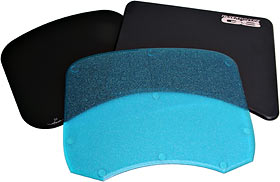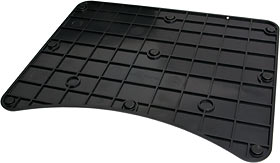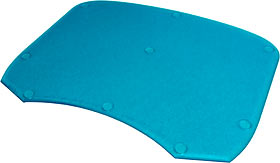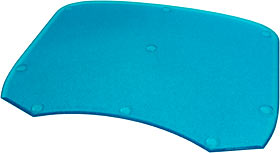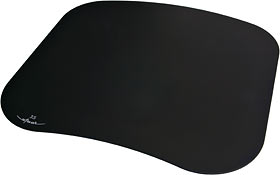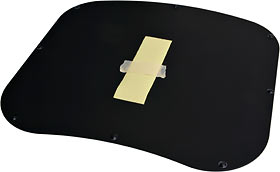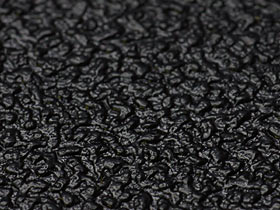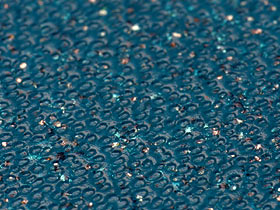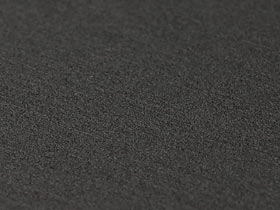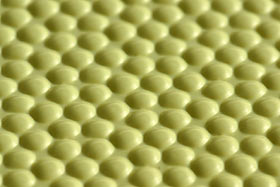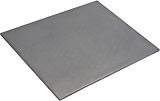
RatpadzGS, Speed-Pad and Steelpad mousemats
Review date: 26 January 2004.Last modified 03-Dec-2011.
Every time another bunch of fancy mousemats drops onto my to-review pile, I wonder whether people are ever going to say "Enough, already!" about these things.
I mean, sure, in Soviet Union, we queue five hours for chance to buy blue cloth-and-rubber mousemat. Then, before we get to front of queue, store runs out.
So, OK, is good that decadent West has many mousemats.
But c'mon. Nobody needs fifty kinds of fancy mousemat. There hasn't actually been a whole lot of innovation in this field since the first hard-plastic Everglide mats showed up about five years ago, but there are still lots of differently branded hard plastic mats. Really, one's much like another.
But hope springs eternal. Maybe someone's had a brainwave.
So here are three recent candidates.
The transparent blue jobbie is a Speed-Pad, the big black one at top right is a Ratpadz GS, and the smaller black mat is a Steelpad 3S. Which, counterintuitively, is made of aluminium.
All three of these pads were available here in Australia from Aus PC Market when I first wrote this piece; their range of mouse accessories has moved on to other stuff now.
On with the show!
Ratting out
I reviewed the original Ratpad a few years ago. Last year, they gave it a major update, and called the result the RatpadzGS.
The GS retains the basic characteristics of the original Ratpad. It's a large mat, at about 11.6 by 9.3 inches (about 295 by 235mm), and it's rectangular, with a deep bite cut out of the front edge for your wrist. It stands about 7.5mm high off your desk - a scant half-millimetre lower than Everglide's current chunky plastic mats. The edge of the Ratpad is, of course, rounded, and the surface has the sort of little irregular smooth nubs all over it that we've come to expect from quality mousemats.
Things get a bit more interesting on the other side. This Ratpad has a rectangular grid of stiffening ribs on its back, instead of just being a solid slab of plastic. It's quite rigid, yet unusually light for a mat this size; it weighs only 278 grams, versus 367g for Everglide's current Gigantas.
This difference is unlikely to excite you if you're not planning to be shot into space, of course.
Speed king
Compad's Speed-Pad is, on the face of it, much the same sort of thing as the RatpadzGS or the Everglide Giganta. It's about the same size, it's got the same sort of surface (a bit finer grained than the current Ratpad; about the same as the current Everglides), and the cutout on the front's a bit smaller. Really, though, much the same.
This is the see-through blue-green version of the Speed-Pad; it comes in some other transparent colours as well, plus plain black. To allow modern optical mouses to track on them, the clear Speed-Pads have glitter cast into them, like the similarly see-through Everglide pads I reviewed here.
The back of the Speed-Pad is smooth and simple, with clear rubber feet around the edge and one in the middle. Like the RatpadzGS I got for review, the Speed-Pad was very pleasingly flat.
The Speed-Pad's very thin for a hard plastic mat, standing only about 4.7mm above the desk. Its thinness no doubt contributes to its low weight - only 286 grams.
Fe by name, Al by nature
There are a variety of Steelpads, all of which are made from aluminium. That's OK; aluminium's a better metal than steel for mousemat construction, since it's more than tough enough and doesn't suffer from destructive corrosion.
The name's still a bit silly, though; a pad with Steel in its name should be steel, like this one.
Anyway, this Steelpad's the 3S model. It's a bit smaller than the giant-sized Speed-Pad and RatpadzGS, at only 250 by 235mm (9.8 by 9.25 inches), but still more than big enough for most people's mousing adventures.
The Steelpad weighs only 262 grams, because an aluminium mousemat doesn't need to be very thick to be stiff. The mat stands only 3.4mm off the desk (the manufacturers say 3.5mm - my calipers presumably squished the rubber foot a bit more).
The edge of the Steelpad is only slightly rounded; they've really just taken the sharp corner off. That's all you need for wrist comfort, when the mat's this close to the desk.
The back of the Steelpad is pretty much featureless, except for the small clear feet and that thing in the middle. That thing is a strip of "PadSurfer" PTFE tape, which you're meant to cut up and apply to the feet of your mouse. I've reviewed this sort of stuff before, but this tape looked rather more exciting.
So I had high hopes, as I engaged the high speed cameras, donned my clean room suit, and moved on to the testing phase of the review.
Surfaces
In extreme close-up, the RatpadzGS looks like a field of knobbly cooled lava; it's noticeably more coarsely textured than most hard plastic mats.
The more aggressive texture ought to be better at keeping dirt particles away from your mouse feet (and ball, if you're an old school mouser) than the surface of other plastic mats, but the difference isn't likely to be big. The Ratpad felt about as smooth under my mouse's feet as one of the various brand new Everglide pads I've got sitting around the place; it's noticeably slicker than the rather worn Everglide I use every day.
The Speed-Pad's texture is less dramatic (and rather more decorative), but still knobbly. It felt much the same as the Ratpad; very slick. Gamers practically all want a super-slick mousing surface, usually because it'll have very little stickiness, and that makes small precise movements easier. Other computer users' tastes vary; most people who use a slick mat for the first time find it grows on them pretty quickly, but some users want something a bit draggier - or a lot.
The Steelpad, in contrast to the plastic pads, has barely any texture at all. It's got a subtle horizontal brushed finish that gives it enough surface detail that optical mouses should track OK (though the manufacturers warn that it doesn't work with Logitech opticals before the MX series).
The Steelpad is very smooth, and a pleasing enough slick mat, provided you don't mind the hissing sound your mouse will make on it, and the cold unyielding feel of the metal.
The basic problem with the Steelpad, and all other metal mousemats, is that they're flat.
On the face of it, you'd think that this was a feature, not a bug. Mousemats are meant to be flat, aren't they?
Well, yes, but they're only meant to be flat overall - not on the millimetre scale. You need texture in the surface of the mat to give dirt somewhere to go. With no texture, any hair or granule or other bit of scurf will sit on the same surface that the mouse feet slide over, and will roll between the feet and the mat, and will annoy you. The Slicksteel pad I review here has this problem.
When I first looked at the PadSurfer tape that comes masking-taped to the underside of the Steelpad, I thought the manufacturers were having a rather clever go at avoiding this problem.
Apparently, they were moving the texture from the mat to the mouse feet!
Unfortunately, my hopes were dashed when I actually pulled the tape off the back of the mat. The knobbly yellow stuff turned out to be the backing paper for the tape itself, which is the same basic flat brown PTFE tape that I've reviewed before. The PadSurfer tape pictured on the Steelpad site looks less exciting, but it's the same stuff.
You get enough tape for at least two tapings of most mouses, and probably three.
With tape on its feet, my aging IntelliMouse Explorer 3.0 (reviewed here) glided over the Steelpad as smoothly as any gamer could wish. As soon as some schmutz got on the pad surface, though, it started grinding away under the taped mouse feet in the usual smooth-pad way.
Mouse foot tape is nice stuff to get as a bonus with your new funky mat, but it does nothing to solve the dead-flat-mat problem.
Destructive testing
One thing you can say for aluminium mousemats is that they ain't gonna wear out. The anodised finish on the Steelpad will survive an arbitrary amount of normal mousing. If you go to Hell and have to play Daikatana for all eternity on a 486SX25 using a mouse with sticky-tape switches, you'll probably wear through the anodising on an aluminium mat some time in the first decade. The metal itself ought to last a lot longer, though.
The durability of plastic mousemats is less certain.
After Everglide embarrassed themselves by making mats out of polystyrene, I've become picky about hard-mousemat plastic. Polystyrene is cheap and hard, but it wears out relatively quickly; in well under a year, polystyrene Everglides could easily wear down to a polished, draggy surface on which optical mouses sometimes skipped, as well as stuck.
Everglide then went back to using less-hard-but-more-tough polyethylene for their mats - I ramble on about this in this review. I wanted to know what Compad and Ratpadz were using.
The easy way to tell what kind of Everglide mat you've got is to dangle it from two fingers and rap it with a knuckle. If it makes a dull click like knocking on a solid door, you've got a polyethylene mat. If it goes "bong", you've got polystyrene.
When I tapped the RatpadzGS, it made this noise. Not a bong, but not a click, either. Hmm.
One very good way to identify plastics is, gentle reader, by setting them on fire. I resisted the urge to torch the whole mousemats (I only do that to review product when I've got spares), and instead carved a few small slivers off an edge.
The RatpadzGS plastic is fairly easy to carve, and comes off in a smooth, bendy curl. If it were straight polystyrene, it wouldn't do this; it'd be hard to carve and the shavings would be flaky.
When I applied a flame to the Ratpad shaving, though, it burned just like polystyrene - a sooty flame that emitted floating smuts, flaming drips, and the distinctive vaguely-like-marigolds smell that only burning polystyrene makes.
So what I reckon this mat's made from is High Impact Polystyrene ("HIP", mentioned on the styrene page here). It's a polystyrene/polybutadiene mixture, with much better impact resistance than plain polystyrene, and probably better wear characteristics too.
I don't know how long the RatpadzGS will actually last, but it's not just a crappy styrene mat.
(HIP isn't the same stuff as Acrylonitrile Butadiene Styrene, ABS, by the way. That's mentioned here, and it's the very hard-wearing plastic that's used for, among other things, Lego bricks.)
On to the Speed-Pad. Tapping it did not fill me with confidence.
It was quite hard to shave, but the shavings weren't fragile, and they didn't burn terribly well. This plastic is hard to light, and at least somewhat "self-extinguishing".
No marigold smell, no drips, no floating soot. Sounds like polycarbonate to me.
Bending the Speed-Pad over my knee confirmed the diagnosis. It's strong and springy and can be bent quite a lot and spring back to perfect flatness; that's polycarbonate all over.
If you plan to treat your mousemat with great disrespect, then polycarbonate is an excellent material to choose. Really, though, I think any mishap that'd injure HIP but not polycarbonate would be drastic enough that some other piece of ruined equipment would be occupying more of your attention.
I don't know what polycarbonate's frictional wear characteristics are like, but I think it's likely to hang in there very well as a mousemat. Once again, this isn't some lousy styrene mat. And it might stop small calibre bullets.
The Speed-Pad has, according to the manufacturers, a "robust, scratch-proof coating" on top of it. Maybe it does; I dunno. Time will tell.
What they cost
In the States, the RatpadzGS lists for less than $US15 from most places, not including delivery. Or less than $US10 from some places, but they're likely to make back the difference in "handling" charges. The main Ratpadz Buy Now page lists a bunch of dealers in the USA and overseas.
$US15 is about $AU19.50, when I first wrote this. At the time, Aus PC Market were charging $AU38.50 for a RatpadzGS (they don't sell them any more). This may at first seem a bit over the top.
Australian shoppers who buy something this size from overseas, however, will find that even a $US10 mousemat can end up a rather expensive proposition. Aus PC Market's price included Australian delivery. The US prices do not.
Many US dealers don't ship internationally, many that do ship internationally won't do it by plain old cheap untracked air mail, and even USPS international air mail for a packaged Ratpad is likely to work out at $14.50 or so, assuming no "handling" charge.
So you were looking at at least $AU32 or so at the current exchange rate, if you can find someone who'll ship to you by air mail. If you can only find courier shipping, fuhgeddaboudit.
So Aus PC Market's price for the RatpadzGS was actually pretty good, as are their current pad prices.
Ther was also an Australian Ratpadz site, by the way, when I first put this review up; there isn't any more.
The Speed-Pad lists for €22.95 for the see-through models, and €18.95 for the plain black one. That was about $AU37.50 and $AU30.90, respectively, at the moment.
Aus PC Market only stocked the clear blue Speed-Pad I checked out; they sold it for $AU45.10 including Australian delivery. So, once again, an OK price.
The Steelpad products page lists pricing for their range of mats and other gizmos in Danish kroner, Euros and US dollars. The 239 kroner price of the Steelpad 3S converted to more than $AU52 when this review was young, and that doesn't seem to include any mouse-foot tape.
Aus PC Market sold the 3S, delivery and PadSurfer tape included, for $AU66.
(They also have the plastic double-sided Steelpad 4D, for $AU52.80, and the extra-big aluminium 4S, for $AU88.)
The question, of course, is whether any mousemat is worth this sort of money. Very large numbers of geeks say that the smoothness of a premium pad is worth a decent chunk of change, and I'm inclined to agree - provided the things don't wear out in less than a year. Which these mats shouldn't.
Overall
The RatpadzGS and Speed-Pad are perfectly good hard plastic mousemats for anybody who's finally worn out their old Everglide (or whatever). Practically speaking, they seem to be the same; the Ratpad's cheaper, but the Speed-Pad's prettier. I don't know which one'll last longer, but neither seems likely to wear out quickly.
The Steelpad's more expensive, and more fiddly. If you like the idea of a metal mousemat, well, here one is; it's nicely presented, a good size, and should last forever. If you're not keen on the idea of blowing dust off your mousemat rather more often than you'll have to if you use a textured mat, though, then the Steelpad is not for you.
Oh well. It looks as if I'm going to have to wait a little longer for the next Great Leap Forward in mousemats.
These ones get the job done, though. And I did get to burn some stuff.
Buy stuff!
Aus PC Market don't stock these mats any more, but they've got plenty of
others!
